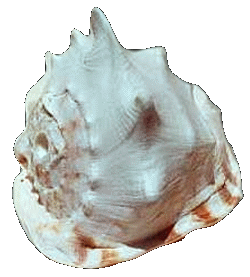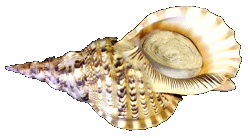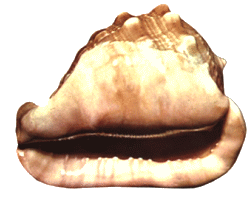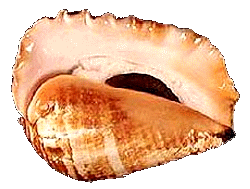Long before our
modern day communication systems, man found that trumpets made from shells
produced a sound that carried for many miles. By using as series of trumpet
blasts, messengers were able to communicate fairly detailed messages from
village to village, tribe to tribe. (Note: The Seashell Trumpet Site is
a great place to learn how to make your own shell trumpets and other instruments!!)
In some countries, shells have been strung or tied together, or they have
had seeds of sand added to them and then been sealed off so that they
act as a rattle. This was then used to accompany song and dance.
Check in here to see how to
make a conch horn, to see what they look like and how they sound.
Some ways in which shells were or still are used are:
- as a summons to religious ceremonies as well as often playing a role in the ceremony itself.
- as a daily call to prayers. Shinto priests in Japan still use the Triton Trumpet shell for this even today!
- as a summons to call warriors to battle and to ring out triumphs in battle.
- as an announcement to herald the entrance of kings, emperors, heroes, or important persons. (or, in Fiji to this very day, to announce that fish is being sold at the market, or at the pier!)
- as a prelude, or to call people to public gatherings, such as tribal or community meetings, feasts, sporting events, etc.
- as a curfew announcement - and is still used in Samoa today, as a signal to proclaim the return of a sailing vessel from a voyage or fishing trip.
- as a fog horn in the Mediterranean.
- as an accompaniment in songs, chants and dance throughout the Indo Pacific.
- as a ritual - blowing of the Triton Trumpet at sundown is still customary in Hawaii today.
Almost any shell modified by drilling a hole into it can be used to make music. Any large shell, unmodified and filled with water, can be used to make musical gurgling sounds (try it!!). Most of us, at some time or other, have held an empty shell up to our ear to hear the music of the ocean waves (Note: The "whooshing" sound you hear is actually a mixture of all the sounds around you, bouncing off the hard sides of the shell: if you could find a completely quiet place to hold a shell to your ear, you wouldn't hear a thing!).
Some shells commonly used for making music, and for signaling devices are:
|
 Cassis cornuta |
 Charonia tritonis |
|
|
 Strombus gigas |
 Cassis tuberosa |
|
|
 Bursa bubo |
 Strombus galeatus |
|